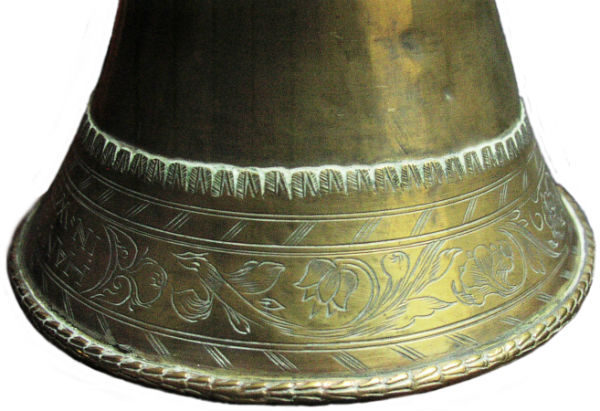Tenor sackbut after Hanns Geyer, Vienna, 1676
 My Baroque tenor trombone (sackbut) maintains the proportions of the originals, including the extremely thin bell and tubing wall thickness and double-anstoss bell construction. All tubes excepting decorative ferrules are handmade; the bell is hammered, spun and burnished by hand. Tubes and bell surface are finished by scraping and burnishing; the interior of the bell retains its dark patina from the annealing process. The bell garland and ferrules are decorated and polished; plating is available upon request. All tubing joints are by friction-fit taper as on the original. The bell rim lies slightly outside 4th position.
My Baroque tenor trombone (sackbut) maintains the proportions of the originals, including the extremely thin bell and tubing wall thickness and double-anstoss bell construction. All tubes excepting decorative ferrules are handmade; the bell is hammered, spun and burnished by hand. Tubes and bell surface are finished by scraping and burnishing; the interior of the bell retains its dark patina from the annealing process. The bell garland and ferrules are decorated and polished; plating is available upon request. All tubing joints are by friction-fit taper as on the original. The bell rim lies slightly outside 4th position.
I also endeavour to match the decoration of the instrument to the original I copy; the bell garland is engraved in a similar manner to the original, and the ferrules have punched and turned decoration. Plating is available upon request, as are simplified decorations if desired.
Tuning: in A at A=466; a short tuning slide may be furnished in the slide section for fine adjustment if desired. I strongly recommend an alternate bell bows for A at 440, as well as a whole-tone tortil after Praetorius for use as a 'baritone' trombone in G - a usage borne out by both iconography and practice. Other bell bows (for example, Bb at A=430 for classical repertoire) are available on request.
Specifications: bore: 10.1 / 10.7mm, bell 102mm.
The Original: Renaissance/Baroque tenor trombone by Hanns Geyer, Vienna, 1676
 In 2009, on a visit to the Schlossmuseum in Linz, Austria, I had the great fortune to be allowed to play and measure two Viennese tenor trombones, built by Hanns Geyer in Vienna, 1676. I have yet to complete my research on the history of these instruments, but based on the engraving of the bell stay, and on typical practice in the region in the mid-seventeenth century, I believe they were likely owned by a church and used primarily in sacred music. The extensive damage and numerous repairs evident on both trombones suggest that they were played frequently and over a long period, and were valued as fine musicmaking tools.
In 2009, on a visit to the Schlossmuseum in Linz, Austria, I had the great fortune to be allowed to play and measure two Viennese tenor trombones, built by Hanns Geyer in Vienna, 1676. I have yet to complete my research on the history of these instruments, but based on the engraving of the bell stay, and on typical practice in the region in the mid-seventeenth century, I believe they were likely owned by a church and used primarily in sacred music. The extensive damage and numerous repairs evident on both trombones suggest that they were played frequently and over a long period, and were valued as fine musicmaking tools.
Both instruments are of a remarkably small bore (10.1 / 10.7mm), and are made of extremely thin material (tubing wall thickness ca. 0.3mm). The response is very flexible and light, with a particularly good high register. When paired with a mouthpiece with a large, sharp throat, the sound is warm and delicate, and lends itself particularly well to colla parte playing as well as chamber music.

Media

This recording features the ensemble Concerto Scirocco (Pietro Modesti, cornetto, Claire McIntyre, alto trombone, myself playing the Geyer tenor, Giulia Gennini, bass dulcian, and Eriko Wakita, organ) and is taken from a live broadcast concert from the studios of RTS Espace 2 in Geneva, Switzerland on Feb. 16, 2014.
Purchase information
 Renaissance/Baroque trombone after Geyer, 1676. Fully historical construction in 0.31mm brass; all tubes formed, soldered and drawn. Seamless tubes are not offered; for me, the acoustic compromise that would entail is unacceptable. All prices in Euro.
Renaissance/Baroque trombone after Geyer, 1676. Fully historical construction in 0.31mm brass; all tubes formed, soldered and drawn. Seamless tubes are not offered; for me, the acoustic compromise that would entail is unacceptable. All prices in Euro.
| Instrument, decorated as original | 3495 |
| Extra bell bow for A=440 | 300 |
| Tortil after Praetorius (1 tone), in two pieces | 475 |
| Tortil after Praetorius (perfect fourth), in two pieces | 550 |
| Tuning mechanism in slide stay (modern compromise) | on request |
| Tuning bit, ca. 10 cent. | 50 |
| Discount for simplified decoration | -500 |
